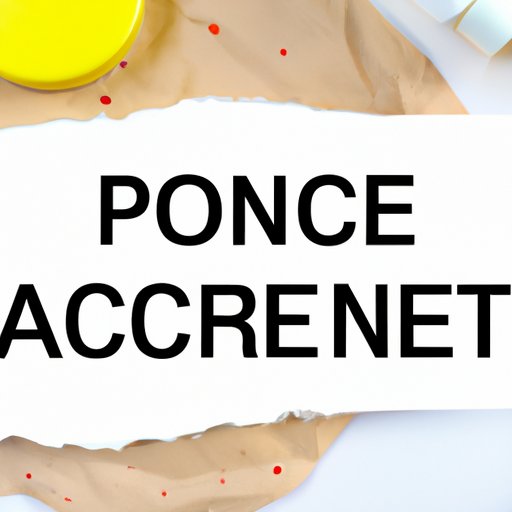Introduction
Acne breakouts can be frustrating, uncomfortable, and sometimes even painful. If you’re looking for ways to get rid of pimples, you’re not alone. This article is designed to help anyone struggling with acne by providing step-by-step recommendations to achieve clearer, healthier-looking skin.
Before diving into the solutions, let’s first review some common factors that contribute to acne breakouts. Hormone imbalances, genetics, stress, diet, and skincare habits can all play a role in acne development. That’s why treating acne requires a multifaceted approach.
Cleansing Routine
A consistent facial cleansing routine is one of the most crucial steps in preventing acne breakouts. When skin is properly cleansed, it removes excess oil, dirt, and bacteria that cause acne and soothes inflammation. Here’s a step-by-step guide to creating a cleansing routine that works for you:
- Wash your face twice a day, once in the morning and once at night.
- Use a gentle facial cleanser that suits your skin type. Avoid harsh, abrasive scrubs that can exacerbate acne symptoms.
- If you wear makeup, remove it using a gentle makeup remover before cleansing your face.
- Rinse your face thoroughly with lukewarm water to ensure all cleanser residue is removed.
- Pat your face dry with a soft towel.
Keeping the Face Moisturized
One common misconception about acne is that it’s caused by overactive oil production. In reality, when the skin doesn’t receive enough moisture, it can produce excess oil, leading to clogged pores and acne breakouts. That’s why keeping the skin moisturized is just as important as keeping it clean. Here are some tips for selecting the right moisturizer:
- Choose a non-comedogenic moisturizer that won’t clog pores.
- Look for products that contain ingredients like glycerin, hyaluronic acid, and ceramides that help hydrate the skin.
- Use a light moisturizer for daytime and a heavier cream for nighttime.
Medication/Creams
Topical medications can be a valuable tool when it comes to treating acne. These products can help unclog pores and reduce inflammation, leading to clearer skin. Here are some medications and creams to consider:
- Benzoyl peroxide – This medication works by killing bacteria on the skin surface and reducing oil production. It’s available in strengths ranging from 2.5% to 10% over the counter.
- Salicylic acid – This beta-hydroxy acid penetrates pores to exfoliate dead skin cells and reduce inflammation. It’s available in a variety of acne treatments.
- Retinoids – These vitamin A derivatives help unclog pores and reduce inflammation. They’re available in prescription-strength creams and gels.
A Healthy Diet
Eating a well-balanced diet can have numerous benefits for overall health, including healthy skin. Consuming nutrient-dense foods can help reduce inflammation and promote healthy skin cell growth. Here are some foods to consider incorporating into your diet to help prevent acne:
- Foods high in antioxidants, such as berries, leafy greens, and nuts can help reduce inflammation that contributes to acne.
- Probiotic-rich foods, such as yogurt or kefir, may help reduce inflammation and promote healthy gut function.
- Foods high in vitamin E, like avocados and almonds, can help repair damaged skin.
Exfoliating
Exfoliating the skin once a week can help remove dead skin cells and unclog pores, leading to clearer skin. Here are some tips for effective exfoliation:
- Avoid harsh scrubs or exfoliators, as they can damage the skin and worsen acne symptoms. Instead, use a gentle chemical exfoliant with ingredients like alpha or beta-hydroxy acids.
- Use warm water to dampen the skin before applying the exfoliant to open up pores.
- Apply the exfoliant using circular motions, focusing on problem areas like the T-zone or cheeks.
- Rinse the skin thoroughly with lukewarm water and pat dry with a soft towel.
Lifestyle Changes
In addition to topical treatments and skincare routines, lifestyle changes can also help prevent acne breakouts. Reducing stress levels, getting enough sleep, and quitting smoking are all factors that can positively impact skin health. Here are some other lifestyle changes to consider:
- Meditation or yoga – Reducing stress through these practices can slow down oil production and offer numerous skin perks.
- Avoiding harsh chemicals and fragrances – Exposure to harsh chemicals and fragrances can irritate the skin and exacerbate acne symptoms. Consider switching to fragrance-free or hypoallergenic products.
- Avoiding touching the face – Hands can carry bacteria and oil that can transfer to the skin, worsening acne symptoms.
Steaming
Another tool that can promote healthy skin is facial steaming. Steaming can help open up pores, soften dirt and oil, and increase blood circulation. Here’s a step-by-step guide for incorporating facial steaming into your skincare routine:
- Fill a large bowl with hot water, bringing it to a comfortable temperature.
- Place a towel over your head to create a steam tent, positioning your face around 6 to 12 inches away from the water.
- Steam your face for 5 to 10 minutes. Be careful not to overdo it, as too much heat can irritate the skin.
- Rinse your face with cold water to close pores and pat dry with a soft towel.
Conclusion
Getting rid of pimples requires a combination of regular skincare habits, healthy lifestyle choices, and topical treatments. By incorporating these tips into your daily routine, you can promote clearer, healthier-looking skin.
Remember, everyone’s skin is different, and it may take some trial and error to find what works best for you. Don’t get discouraged if results aren’t immediate, and consult a dermatologist if you’re experiencing severe or persistent acne breakouts.
